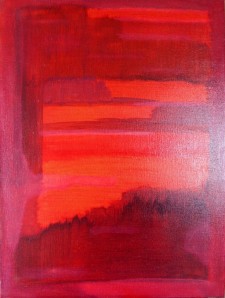My homework assignment for the week:
This was the week I was looking forward to most of all. Mark Rothko has been my inspiration since seeing his 'Red on Red' painting at the National Gallery in Australia a decade ago. I still remember my first encounter with a Rothko, as it bought me to tears. I sat there transfixed for almost an hour (with my then date, now my husband, wandering the Gallery in wait for me) as Rothko's painting washed over me, filling me with a feeling unmatched, until quite recently when I visited MoMA in NYC and walked into the room of Barnett Newman Paintings. (It was actually a relatively small work that got my attention first Titled 'Abraham' , it too flooded me with emotion).
When I first started to study Painting, I was very influenced by what I had seen of Rothko. I loved layering and glazing, applying colors and seeing how they influenced one another, so it was very surprising to discover during my course that there was a vital factor in Rothko's technique I hadn't understood, his method of mixing his pigment with vast amounts of solvent. With all my layering and glazing over the years I had been more than happy with the glossy outcome of mixing medium with my oils and so I had not ventured beyond it. When it was time to execute my weekly homework assignment, following the tutorial, I mixed up the Turpentine and Pigment only to discover how completely different it was to apply to the canvas,than the method of layering I had used to date. The paint felt dry going on the canvas, the smooth feeling I was used to was not there at all. The stain of color that was applied could be moved around to varying consistency in a way that was also new. I could sweep some of the paint just applied into a corner of the area I was working on, in a way that built up the opacity in that part and thinned it out from the other. With the medium mix, the paint would almost 'level off' after application to a smooth surface and I would have to wait until it was dry in order to apply a subsequent layer, with the solvent it felt touch dry very quickly and I could apply a number of successive coats in a sitting!
It was a moment of clarity for me, a new way of approaching layering. I stayed in the studio all day, admittedly only coming out after breathing in way too much solvent and getting quite a headache. The revelation was worth it though. It opened me up to approaching what I had been doing in a different manner. I wouldn't have to lose the glossiness I love but could work numerous layers before getting into a layer with gloss. This now means I can work faster to achieve numerous layers with a finer degree of control over the various transparencies. It's interesting to note how many techniques I had been applying that I discovered Rothko also employed, although to be honest, I am not sure if it was intuitive on my part, or as a result of having many artist books about Rothko, that perhaps I had read about his techniques and they had entered into my subconscious, only to return when painting. I hadn't ever thought about it until my MoMA week on Rothko.
When painting,I turn my abstracts sideways and upside down as I apply various layers, I allow drips to remain as part of the journey in the layers without brushing them out and I usually apply a single color in a session but use the brush with some remaining color from the layer preceding it. This was a quirky thing I did without really thinking about the process. It symbolized each layer being part of the whole and not separate from the last, but in studying his techniques I learnt, (albeit, obvious in hindsight) that it enables the colors to resonate a little more easily, having a touch of the other color mixed in, whether one can see it or not. Another similarity I thought came from within myself, that may have been an influence of reading, is to paint the edges of a canvas as a means to incorporate the actual canvas itself into the painting. Rothko did this deliberately, in order to present the painting as more of an object in itself, rather than as some artists whom leave it white, to establish more of a picture plane presented on canvas. I have enjoyed thinking about the process and why one does a certain technique, it has enabled a new way of thinking about the outcome with a more deliberate approach. I am used to working intuitively and watching, almost as an observer whilst the painting made itself. I have felt the painting guides me along the way rather than that I was mastering the outcome.
Although I doubt if I will change my approach in this element of painting, as it is a large part of what I love about the act itself, it has opened up the possibility of having more control if I so choose. Here is some of my layered work to date, before the course began:







